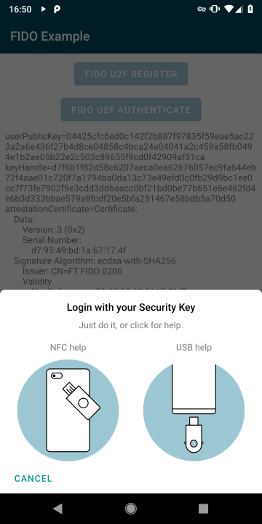FIDO U2F
In this guide, you’ll learn how to integrate the Hardware Security SDK in your app to extend your login mechanism with two-factor authentication. This is done by first registering a FIDO U2F Security Key in your user’s profile. Later, a login using username/password is extended using a second-factor authentication with FIDO U2F Security Keys.
Add the SDK to Your Project
To get a username and password for our Maven repository, please contact us for a license.
Add this to your build.gradle:
repositories {
google()
jcenter()
maven {
credentials {
username 'xxx'
password 'xxx'
}
url "https://maven.cotech.de"
}
}
dependencies {
// FIDO implementation
implementation 'de.cotech:hwsecurity-fido:4.4.0'
// Additional classes for local parsing and verification of FIDO messages
// Usually not required for FIDO clients.
//implementation 'de.cotech:hwsecurity-fido-util:4.4.0'
}
Initialize the Hardware Security SDK
To use the SDK’s functionality in your app, you need to initialize the SecurityKeyManager first.
This is the central class of the SDK, which dispatches incoming NFC and USB connections.
Perform this initialization in the onCreate method of your Application subclass.
This ensures Security Keys are reliably dispatched by your app while in the foreground.
We start by creating a new class which extends android.app.Application as follows:
public class MyCustomApplication extends Application {
@Override
public void onCreate() {
super.onCreate();
SecurityKeyManager securityKeyManager = SecurityKeyManager.getInstance();
SecurityKeyManagerConfig config = new SecurityKeyManagerConfig.Builder()
.setEnableDebugLogging(BuildConfig.DEBUG)
.build();
securityKeyManager.init(this, config);
}
}
class MyCustomApplication : Application() {
override fun onCreate() {
super.onCreate()
val securityKeyManager = SecurityKeyManager.getInstance()
val config = SecurityKeyManagerConfig.Builder()
.setEnableDebugLogging(BuildConfig.DEBUG)
.build()
securityKeyManager.init(this, config)
}
}
Then, register your MyCustomApplication in your AndroidManifest.xml:
<application
android:name=".MyCustomApplication"
android:label="@string/app_name"
... >
FIDO Security Key Registration
Show our FidoDialogFragment to register a Security Key:
private void showFidoRegisterDialog() {
// Make a registration request to the server. In a real application, this would perform
// an HTTP request. The server sends us a challenge (and some other data), that we proceed
// to sign with our FIDO Security Key.
String fidoAppId = "https://fido-login.example.com";
String fidoFacetId = FidoFacetIdUtil.getFacetIdForApp(context);
byte[] challengeBytes = new byte[] {}; // Insert 16 bytes random challenge
String registerChallenge = WebsafeBase64.encodeToString(challengeBytes);
FidoRegisterRequest registerRequest = FidoRegisterRequest.create(fidoAppId, fidoFacetId, registerChallenge)
// This opens a UI fragment, which takes care of the user interaction as well as all FIDO
// internal operations for us, and triggers a callback to #onRegisterResponse(FidoRegisterResponse).
FidoDialogFragment fidoDialogFragment = FidoDialogFragment.newInstance(registerRequest);
fidoDialogFragment.show(getSupportFragmentManager());
}
Implement OnFidoRegisterCallback in your Activity and override onFidoRegisterResponse to receive callbacks from the FidoDialogFragment:
@Override
public void onFidoRegisterResponse(@NonNull FidoRegisterResponse registerResponse) {
// Forward the registration response from the FIDO Security Key to our server application.
// The server will perform some checks, and then remember this FIDO key as a registered
// login mechanism for this user.
}
FIDO Authentication
Authentication is now done by creating a FidoAuthenticateRequest:
private void showFidoAuthenticateDialog() {
// Make an authentication request to the server. In a real application, this would perform
// an HTTP request. The server will send us a challenge based on the FIDO key we registered
// before (see above), asking us to prove we still have the same key.
String fidoAppId = "https://fido-login.example.com";
String fidoFacetId = FidoFacetIdUtil.getFacetIdForApp(context);
byte[] challengeBytes = new byte[] {}; // Insert 16 bytes random challenge
String authChallenge = WebsafeBase64.encodeToString(challengeBytes);
byte[] keyHandle = new byte[] {}; // Insert keyHandle from previous FidoRegisterResponse
FidoAuthenticateRequest.create(fidoAppId, fidoFacetId, authChallenge, keyHandle);
// This opens a UI fragment, which takes care of the user interaction as well as all FIDO internal
// operations for us, and triggers a callback to #onAuthenticateResponse(FidoAuthenticateResponse).
FidoDialogFragment fidoDialogFragment = FidoDialogFragment.newInstance(authenticateRequest);
fidoDialogFragment.show(getSupportFragmentManager());
}
Implement OnFidoAuthenticateCallback in your Activity and override onFidoAuthenticateResponse:
@Override
public void onFidoAuthenticateResponse(@NonNull FidoAuthenticateResponse authenticateResponse) {
// Forward the authentication response from the FIDO Security Key to our server application.
// The server will check that the signature matches the FIDO key we registered with, and if
// so we have successfully logged in.
}
Prevent Re-Creation of Activity with USB Security Keys
Besides the functionalities used by our SDK, some Security Keys register themselves as USB keyboards to be able to insert One Time Passwords (OTP) when touching the golden disc. Thus, when inserting a Security Key into the USB port, Android recognizes a new keyboard and re-creates the current activity.
To prevent this, add keyboard|keyboardHidden to the activity’s configChanges in your AndroidManifest.xml:
<activity
android:name=".MyCustomActivity"
android:configChanges="keyboard|keyboardHidden"
... >
Congratulations!
That’s all! If you have any questions, don’t hesitate to contact us:



